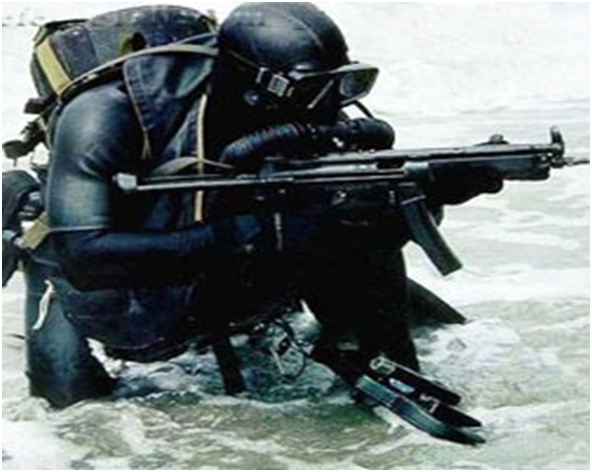INDIA'S SPECIAL FORCES FACE AN IDENTITY CRISIS
Indian Special Forces

NEW DELHI: India’s manpower intensive Special Forces (SF), which continue to operate without a specific operational mandate, adequate gear, organisational support or dedicated funding, face an identity crisis.
Senior military officers concede that the country’s under-equipped SF units are deployed routinely on tactical rather than broader, strategic and unconventional missions that were envisaged for them in a turbulent neighbourhood.
Consequently the SF, whose numbers have proliferated recklessly 2001 onwards, have often ended up as substitutes for conventional forces in counter-insurgency operations (COIN) in the Northeast, Punjab and Kashmir, that could well have been undertaken by regular infantry.
There are more maroon berets (of the SF) visible in Kashmir than necessary. For such an elite force with a seemingly diverse orientation to be employed on search-and-cordon and long-range path finding tasks and execute attacks on terrorist hideouts is, simply, overkill. All such responsibilities can easily be effected by the infantry’s Ghatak commando platoons, trained and equipped for special operations.
Experts argue that such employment only militates against fundamental SF ethos, their unconventional skills and proficiency, all of which are aimed at a precise and focused response for high value gains.
All militaries concur, that by virtue of specialised and demanding training, exploitation of advanced weaponry and equipment, strategic mobility and tactical flexibility, most SF are any country’s high-octane force multipliers.
Capable of functioning in ambiguous and evolving scenarios and adapting swiftly to crisis situations, their primary aim is to maximise military, diplomatic and political outcomes for their respective governments.
It is, after all, an accepted axiom in military and security circles, that much like the lone sniper, SF too are capable of altering, not only the course of battles, but even of politics and history. And like the sniper, their roles remain shrouded in secrecy.
Accordingly all SF, glamourised by cinema and fiction, are deemed capable of conducting spectacular operations, in inverse proportion to their numbers employed in assorted conflict spectrums. The stunning US Navy SEAL Team Six raid on Abbotabad cantonment in northwestern Pakistan in May 2011, to assassinate Osama bin Laden, is one such recent example.
In India, however, the absence of a centralised SF authority and doctrine, command-and-control structure and confusion over their allocation to joint or single service commanders, has resulted in lop-sided capability development and at times, even mission duplication.
An SF doctrine issued by the Integrated Defence Staff (IDS) in 2005, decades after the first battalion was raised in 1978, was more a generic document that failed in providing mission clarity or resolving innumerable operational anomalies.
The lack of standarised training and equipping norms has further added to SF operational ambiguities creating, instead, a ‘stove pipe’ or silo-like structure of multiple elite forces operating in isolation, albeit to little strategic effect.
Hence, Indian SF rarely, if at all, function as an effective politico-military tool.
There is near unanimity amongst military and security officers that poorly trained and accoutered SF remain largely incapable of effectively implementing raids, ambushes, direct assaults or standoff attacks in hostile territory.
Furthermore, they are ill suited to conducting strategic reconnaissance and unconventional warfare or executing a wide range of critical challenges that have emerged in India’s neighbourhood in recent years, like locating and seizing weapons of mass destruction.
“India’s SF are so only in name, not orientation because the country’s higher defence organisation lacks military professionals. Their ability to employ SF on politico-military missions at strategic levels is lacking” lamented Lieutenant General Prakash Katoch, a former SF officer. They (SF) continue to be employed tactically, he added.
The bulk of India’s 18,000-20,000 strong SF, including support units, or some 7,000-8,000 personnel are from the Indian Army, which is in the process of raising its 10th Para (SF) battalion.
These overall, proliferating numbers equal those of the US Special Operations Command (SOCOM), even though the operational remit of Indian SF is severely circumscribed, confined to its immediate neighbourhood, whilst that of the former is global.
The remaining SF comprise the Indian Navy’s (IN’s) 1,000-1,200 Marine Commandoes (MARCOS) and the Indian Air Force’s (IAF’s) 1,200-odd Garud Commando Force.
Additionally, there are 4,000-5,000 SF personnel from the 51 and 52 Special Action Group (SAG), drawn exclusive from the army, that constitute the principal strike arm of the National Security Guard (NSG), a Federal Contingency Deployment Force that operates under the Cabinet Secretariat.
After the November 2008 Mumbai terror strikes, these SAG numbers are gradually being increased, following the decision to expand NSG deployment to Mumbai, Kolkata, Hyderabad and Chennai, in anticipation of similar attacks elsewhere in the country.
This wider NSG dispersal, presently underway, nearly seven years after the Mumbai siege, was also prompted by the forces five-hour delay on 26 November 2008 in deploying, from its headquarters at Manesar on New Delhi’s outskirts, against the 10 Pakistani terrorists besieging Mumbai.
During operations, three Special Ranger Group (SRG) battalions-11,12 and 13- of around 900 personnel each, recruited from State and Central Para-Military Forces, provide logistic support to the SAG.
However, years of depreciated operating procedures, under which SRG personnel have thoughtlessly been assigned to VIP security, has severely blunted their combat edge.
Furthermore are 1,200-1,500 SF from two shadowy Special Group (SG) battalions of the Special Frontier Force (SFF), raised after India’s disastrous 1962 border war with China, and headquartered at Chakrata, near Dehra Dun. The SFF and its SG served as models for the NSG- SAG combine.
The SFF-better known by its nom du guerre Establishment 22-is operationally employed by the Intelligence Bureau (IB) and the Research and Analysis Wing (RAW) for clandestine and sensitive missions.
Interestingly, the SFF came to be known by this latter appellation due to its first Inspector General, the doughty Major Gen Sujjan Singh Uban, who commanded the 22nd Mountain Regiment during World War II, winning a Military Cross in the process.
(Tomorrow: Special Forces Part Two)
(Defence and Security of India-Media Transasia Publication. )



